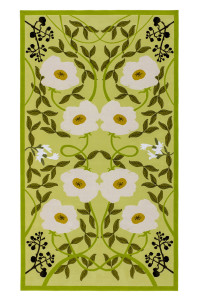Kapwani Kiwanga

GLEAN Podcast
GLEAN senior editor Els Roelandt spoke with artist Kapwani Kiwanga to discuss Kiwanga’s site-relational installation Rootwork at Bozar, Brussels (Rootwork was on view from 10 November 2023 to 24 March 2024). Listen here.
Visual artist Kapwani Kiwanga, who will represent her native Canada at the 2024 Venice Biennale, is presenting a site-relational artwork called Rootwork at Bozar Brussels. Interestingly, her presentation coincides with the exhibition ‘Victor Horta and the Grammar of Art Nouveau’ also at Bozar. 2023 is the year in which Belgium commemorates the construction of the Hôtel Tassel in Brussels, the first Art Nouveau house designed by Victor Horta for Professor Emile Tassel, a member (as was Victor Horta) of the Masonic lodge called Les Amis Philanthropes, an organisation linked to the exploitation of Congo during the colonial period. At Bozar, Kiwanga exhibits a carpet with floral motifs including baobab flowers and white rubber vines. These motifs underline the importance of community and interconnectedness, but also reference hidden cruelty and exploitation. It is no longer a secret that the development of Art Nouveau in Belgium was linked to the exploitation of Congo by King Leopold II, the Belgian state and the political, cultural and economic elite of the late nineteenth century. Thanks to recent research revealing hidden or covered-up ties between Congo’s exploitation and Art Nouveau’s flourishing, such links can now be publicly discussed, as is the case with the exhibition ‘Victor Horta and the Grammar of Art Nouveau’. Kiwanga makes the link between aesthetics and the movement’s power structures extra clear in her work. In an essay published in the exhibition’s catalogue, professor Deborah Silverman argues that the Belgian design of Art Nouveau set up an aesthetics of domination and was an exclusionary project that privileged patrons, while refusing to acknowledge Congo’s influence on the movement. Art Nouveau architect Henry Van de Velde described the liane (French for creepers), one of Art Nouveau’s central motifs, as a ‘whiplash’ in reference to brutal instruments of torture used in the former colony. In the exhibition ‘Victor Horta and the Grammar of Art Nouveau’ and its accompanying catalogue, one finds illuminating passages, archived material and recent research that explicitly demonstrate how the roots of European Modernism are linked to a violent and oppressive colonial regime. In his catalogue introduction, CEO and Artistic Director of Bozar Christophe Slagmuylder promises to further investigate Western heritage through contemporary art. Those interested in the connection between Congo, Art Nouveau and early modernism ought to check out Congo Style: From Belgian Art Nouveau to African Independence, the absolutely marvelous study by artist and researcher Ruth Sacks published in 2023 by the University of Michigan Press.